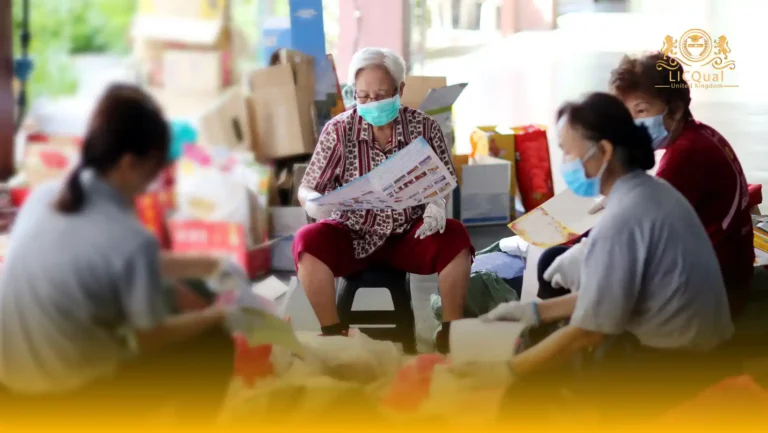The LICQual Level 3 Award in Working at Height is an advanced qualification tailored for experienced professionals responsible for managing, supervising, or carrying out high-risk tasks at elevation. This course provides comprehensive knowledge of safe practices, legal obligations, risk assessment strategies, and emergency procedures related to working at height. As industries increasingly emphasize health and safety standards, this qualification plays a crucial role in ensuring that senior personnel are well-equipped to maintain safety on elevated work sites.
The LICQual Level 3 Award in Working at Height covers a wide range of essential topics including fall prevention systems, planning and organizing work at height, the selection and inspection of personal protective equipment (PPE), and compliance with national and international safety regulations. Participants will explore best practices for supervising teams, responding to emergencies, and implementing effective safety controls. The course also includes advanced modules on rescue planning, risk mitigation, and developing safe work method statements.
Ideal for team leaders, supervisors, safety officers, and managers, this qualification empowers learners with the skills and confidence to oversee complex work-at-height operations. The LICQual Level 3 Award in Working at Height supports career advancement and demonstrates a commitment to maintaining high safety standards in dynamic and hazardous environments. Learners will also gain insight into common mistakes and accident trends, allowing them to proactively address potential risks before they escalate.
Delivered through a combination of theory-based instruction, interactive case studies, and scenario-based learning, the LICQual Level 3 Award in Working at Height is structured to meet international training standards. Participants will learn how to assess real-world work sites, apply control measures, and lead teams with competence and clarity. The training environment promotes critical thinking and practical decision-making essential for high-stakes situations.
The LICQual Level 3 Award in Working at Height is a valuable credential for professionals seeking to deepen their expertise in height safety management. It enhances organizational safety culture, minimizes operational risks, and aligns with regulatory compliance requirements. Upon successful completion, learners will receive a recognized certificate, affirming their ability to plan, supervise, and execute working at height operations with efficiency and safety at the forefront.
Course Overview
Qualification Title
LICQual Level 3 Award in Working at Height
Total Units
6
Total Credits
6
GLH
18
Qualification #
LICQ2200443
Qualification Specification
To enroll in the LICQual Level 3 Award in Working at Height applicants must meet the following criteria:
|
Qualification# |
Unit Title |
Credits |
GLH |
|---|---|---|---|
|
LICQ2200443-1 |
Planning and Supervising Work at Height Activities |
1 |
3 |
|
LICQ2200443-2 |
Legal Compliance and Industry Standards |
1 |
3 |
|
LICQ2200443-3 |
Advanced Risk Assessment and Method Statements |
1 |
3 |
|
LICQ2200443-4 |
Supervising Use of MEWPs, Scaffolds, and Complex Equipment |
1 |
3 |
|
LICQ2200443-5 |
Investigating Incidents and Implementing Preventative Measures |
1 |
3 |
|
LICQ2200443-6 |
Leadership in Height Safety and Promoting a Positive Safety Culture |
1 |
3 |
By the end of this course,applicants will be able to:
1. Planning and Supervising Work at Height Activities
- Develop comprehensive work plans for height-related activities, incorporating safety controls and operational needs.
- Allocate resources and coordinate teams effectively to ensure safe execution of height tasks.
- Monitor and supervise work at height to ensure compliance with safety protocols and timelines.
- Evaluate the effectiveness of work plans and make adjustments to improve safety and efficiency.
2. Legal Compliance and Industry Standards
- Interpret relevant legislation, regulations, and industry standards relating to work at height.
- Ensure organizational policies and procedures align with legal requirements.
- Assess the implications of non-compliance for individuals and employers.
- Promote adherence to national and international safety standards within the workplace.
3. Advanced Risk Assessment and Method Statements
- Conduct detailed risk assessments for complex height-related operations.
- Develop and implement robust method statements to support safe working procedures.
- Apply the hierarchy of control to eliminate or reduce height-related hazards.
- Review and update assessments and method statements to reflect changing conditions or findings.
4. Supervising Use of MEWPs, Scaffolds, and Complex Equipment
- Evaluate the suitability and safe application of MEWPs, scaffolding, and specialized equipment.
- Supervise the correct setup, use, and dismantling of height access equipment.
- Ensure operators are trained, competent, and adhere to safety requirements.
- Identify equipment faults and ensure appropriate inspection and maintenance procedures are followed.
5. Investigating Incidents and Implementing Preventative Measures
- Lead thorough investigations into work at height incidents and near misses.
- Apply root cause analysis techniques to identify contributing factors.
- Develop and recommend corrective and preventive actions to mitigate future risks.
- Communicate investigation findings effectively to relevant stakeholders.
6. Leadership in Height Safety and Promoting a Positive Safety Culture
- Demonstrate leadership behaviors that reinforce a strong commitment to height safety.
- Engage and motivate teams to prioritize safe working practices.
- Implement strategies that embed a proactive safety culture within the organization.
- Monitor and evaluate the impact of leadership on workforce safety attitudes and behaviors.
This diploma is ideal for:
- Health and safety officers responsible for overseeing work at height activities
- Site supervisors and foremen managing teams in construction or maintenance roles
- Project managers coordinating high-risk operations involving elevated work
- Team leaders in industries such as utilities, telecom, or oil and gas
- Engineers and technicians who supervise or inspect elevated structures
- Facility and operations managers overseeing rooftop or elevated maintenance
- Risk assessors and safety consultants specializing in height-related hazards
- Experienced workers looking to advance into supervisory or leadership positions
- Personnel involved in planning or approving method statements and risk assessments
- Individuals tasked with selecting and inspecting height access equipment
- Trainers and educators delivering instruction in height safety practices
- Incident investigators responsible for analyzing fall-related events
- Compliance managers ensuring alignment with legal and industry standards
- Contractors and subcontractors seeking formal recognition of height safety competence
- Anyone aiming to promote a proactive safety culture within their organization
Assessment and Verification
All units within this qualification are subject to internal assessment by the approved centre and external verification by LICQual. The qualification follows a criterion-referenced assessment approach, ensuring that learners meet all specified learning outcomes.
To achieve a ‘Pass’ in any unit, learners must provide valid, sufficient, and authentic evidence demonstrating their attainment of all learning outcomes and compliance with the prescribed assessment criteria. The Assessor is responsible for evaluating the evidence and determining whether the learner has successfully met the required standards.
Assessors must maintain a clear and comprehensive audit trail, documenting the basis for their assessment decisions to ensure transparency, consistency, and compliance with quality assurance requirements.







